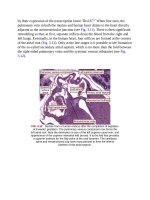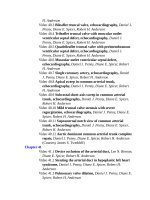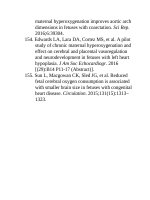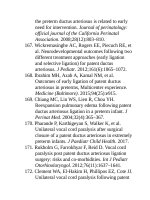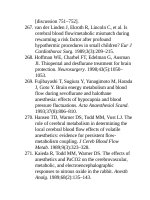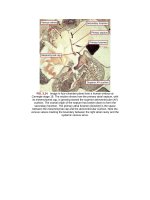Andersons pediatric cardiology 1067
Bạn đang xem bản rút gọn của tài liệu. Xem và tải ngay bản đầy đủ của tài liệu tại đây (115.44 KB, 3 trang )
FIG.40.19 Representativemeasurementsofoxygensaturations(A;in
percent)andpressures(B,inmmHg)obtainedduringcardiac
catheterizationinapatientwithcommonarterialtrunk.Thereisevidenceof
asubstantialleft-to-rightshunt,withtheoxygensaturationinthepulmonary
arteries,exceedingthatinthecavalveins.Nonetheless,theoxygen
saturationintheaortaexceedsthatinthepulmonaryarteriesbecauseof
streaming.Pressuresintherightandleftventriclesareequal,andthereis
noevidenceofstenosisofthetruncalvalve.Thepressurethatwas
measuredintheleftpulmonaryarteryisslightlylessandthatintheright
pulmonaryarteryandsignificantlylessthanthatintheaorta,reflectinga
stenosisoftheoriginoftherightpulmonaryartery.
Measurementsofpressurewillreveal,inthetypicalcase,similarpressuresin
therightandleftventricles.Theremaybeminordifferencesbetweenthe
measurementsinthetwopulmonaryarteries,andbetweenthepulmonary
arteriesandtheaorta,whichmayreflectstreaming.Pressuredifferencesmay
alsoreflectobstructionatthepointoforiginofpulmonaryarteriesfromthe
aorta,orinonepulmonaryartery.Suchdifferencesinpressurebetweentheaorta
andthepulmonaryarteriesmaybefoundinalmosthalfofthepatients.33Any
differencesinsystolicpressureshouldbenotedacrossthetruncalvalve.These
occurinone-thirdofpatientsandvaryfrom10to60mmHg.Nonetheless,
minordifferencesinpressurearecommonandreflectexcessiveflow,ratherthan
truncalstenosis.Selectiveangiocardiographyshouldbeperformed,first,inthe
truncalroot,filminginfrontalandlateralprojections.Elongatedrightanterior
obliqueviewsshowwellthedivisionoftheaorticandpulmonarypathwaysfrom
thetrunk.34Rapidinjectionsofcontrastarenecessarytoavoidexcessivedilution
ofthecontrastmediumbythetorrentialflow.Suchaninjectionshould
demonstratetheanteriortiltofthetruncalroot,theoriginofoneorboth
pulmonaryarteriesfromtheascendingtrunk,andthedegreeoftruncal
regurgitation.Thearteriescanalsoarisefromotherunusualsites,suchasoneof
thetruncalsinuses.Aninjectioninthetruncalrootwillusuallydemonstrateany
interruptionoftheaorticarchandshouldalsorevealanyunilateralabsenceof
onepulmonaryartery,anassociationfoundinbetweenone-tenthandone-sixth
ofpatients.Ifsuspected,afurtherdescendingaortogram,andselective
injection(s)intocollateralarteries,orevenpulmonaryvenouswedgeinjections
onthesideoftheabsentpulmonaryartery,shouldclarifywhethertheartery
reallyisabsent,orwhetheritoriginallyderiveditsbloodsupplyfromanarterial
duct.
SurgicalTreatment
Earlyattemptsatsurgicalpalliationinvolvedbandingthepulmonaryarteries,
eitheratthelevelofaconfluentpulmonaryarterialsegment,orseparatelyforthe
rightandleftarteries.Thisprocedurehasnowbeenalmostcompletely
abandoned,infavorofcomplete,earlysurgicalrepair.Thefirstsuchcomplete
repairofcommonarterialtrunk,usinganonvalvedconduit,wasatthe
UniversityofMichiganin1963,whereasthemorecommonlyusedapproachof
repairusingavalvedconduittorestorecontinuityfromtherightventricletothe
pulmonaryarteries,wasachievedattheMayoClinicinSeptember1967.35,36
Bothpulmonaryarteriesaredissecteddowntotheirpointsofbranchinginthe
hilumsofbothlungs.Theaortaisfullymobilized.Thesurgeryisperformed
underhypothermiccardiopulmonarybypass.Thedegreeoftruncal
incompetenceiscarefullyassessed.Significantregurgitationmayinterferewith
myocardialprotection.Incasesofsignificanttruncalvalveregurgitation,direct
administrationofcardioplegicsolutionintothecoronaryarteryoriginsortheuse
ofretrogradecardioplegiaviathecoronarysinusmaybenecessary.The
pulmonaryarteriesaredetachedfromthecommontrunk,takingcaretoavoid
anycoronaryarterialorigins.Thedefectintheaortamaybeclosedbydirect
suture,orwithasmallpatchofsyntheticmaterial,homograft,orpericardium.If
thereisnoconfluentpulmonaryarterialsegment,accessisimprovedby
transectingtheascendingcomponentofthecommontrunk.Theseparate
pulmonaryarteriesareexcisedwiththeinterposedportionoftrunkasasingle
button,andtheascendingaortaisreconstructedasanend-to-endanastomosis.
Theventricularseptaldefectisclosedwithapatchinsuchawayastoconnect
theremainingaorticcomponentofthetrunkwiththeleftventricle.Continuity
betweenthepulmonaryarteriesandtherightventriclecanoftenbeestablished
withtheaortacross-clampedwhilethepatientisbeingrewarmed.Withadequate
mobilizationofthepulmonaryarteries,itshouldbepossibletoanastomosea
valvedconduit,usuallyahomograft,directlyontotherightventriculotomy
withoutanyprostheticinterposition(Video40.12).
Becausetheavailabilityofhomograftsmaybelimited,andtoavoidthelongtermproblemsofhomograftstenosis,modificationstotheprocedurehavebeen
describedthatavoidtheiruse.Inonesuchmodification,continuitybetweenthe
rightventricleandpulmonaryarteriesisachievedwithoutuseofaconduit.This
